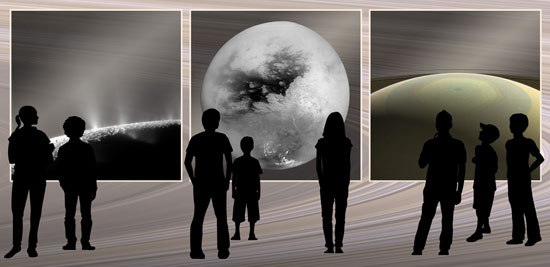The Paris Observatory coordinates for the whole of France the 2016-2017 edition of the ESA contest "Instant scientist with the Cassini probe" : the purpose is: :
* to publicize the contest among schools ;
* to gather the texts :
* to establish the winner and to send out the prizes.

The purpose of this contest is to initiate children in space research, by writing a not more than 500 word essay explaining why they chose that particular target rather than three of the ones observed by the Cassini probe in orbit around Saturn since twelve years.
Participation
The contest is open to all the school children in the countries making up or coorperrating with ESA in 2016/2017, i.e. *Germany, Austria, Belgium Denmark, Spain, Estonia, Finland, France, Greece, Ireland, Italy, Norway, Holland, Poland, Portugal, The Cheque Republic, Roumania, the United Kingdom and Sweden.*
To participate in the contest, the school children (aged between 10 and 18 years old) should first find as much informamtion as possible about the magnificent planet Saturn and its fascinating satellites. After which they will have to choose one of the three targets observed by the Cassini probe, and write a (500 word maximum) essay justifying their choioce.
The essays should be sent to the contest coordinator in each of these countries, who will select the winner(s) for his/her country. The winners of the contest will receive a prize and a certificate issued by the European Space Agency, and the winning essays will be published on the Agency’s internet site.
The essas will be assessed in three age groups : 10–12, 13–15 and 16–18 years old. Participation can be on an individual level, or via four member temas. The essays can be written in French or English. Only one essay can be submitted per participant or per team.
Please indicate the age group on each submitted essay.
Closing date for the contest is *3rd April 2017 at 23:59 CET*.
Which of these three targets would you choose ?
To participate in the contest, one just needs to examine the three targets observed by the Cassini probe and to explain why the one you have chosen will leed to the most interesting scientifric results. Here are the three targets proposed this year (details given below) :
- The ice covering on Enceladus
 Les panaches de glace au pôle sud d’EnceladeDes panaches spectaculaires de toutes dimensions émettent glace et
Les panaches de glace au pôle sud d’EnceladeDes panaches spectaculaires de toutes dimensions émettent glace et
vapeur d’eau en de nombreux points le long des fameuses "griffures
de tigre" situées près du pôle sud d’Encelade, un des satellites de
Saturne. Ces quatre "griffures" sont en fait d’imposantes fractures
d’environ 135 km de long à travers les terres australes du satellite.
Cette mosaïque, constituée de deux images, est l’une des vues les plus
résolues obtenues par la sonde Cassini dans son étude systématique
de l’activité des geysers d’Encelade. - Titan’s lakes
 Les lacs de TitanCette mosaïque de neuf images prises par la sonde Cassini lors de son
Les lacs de TitanCette mosaïque de neuf images prises par la sonde Cassini lors de son
premier passage rapproché de Titan le 26 Octobre 2004 constitue la
vue la plus détaillée de l’ensemble du disque de cet intrigant satellite.
Les images ont été traitées en vue d’atténuer les effets de diffusion
par l’atmosphère et d’accentuer les détails de la surface. - Saturn’s hexagon
 L’hexagone au pôle nord de SaturneDans cette image en couleurs naturelles prise par la caméra grandangle
L’hexagone au pôle nord de SaturneDans cette image en couleurs naturelles prise par la caméra grandangle
de la sonde Cassini, le globe de Saturne ressemble à une
décoration de Noël. On distingue la forme hexagonale de couleur
jaunâtre caractéristique du courant-jet septentrional de Saturne. Au
pôle même, siège la version saturnienne d’un puissant cyclone, oeil
compris.
The Cassini-Huygens mission
The Cassini-Huygens mission is an international project conducted by NASA, ESA and the Italian space agency ASI. In 2004, after an almost seven year trip, the probe made up of NASA’s Cassini orbiter and ESA’s atmospheric probe Huygens , was the first craft to be put in orbit around Saturn.
In January 2005, the Huygens probe landed on the surface of Titan, the largest of Saturn’s satellites. This was the only time that a probe was landed on a body so far from the Earth, on a body of the other solar system.
The Cassini probe is still in orbit around Saturn, yielding considerable amounts of information about the giant planet and its satellites. Now in its last phase, the probe has less than a year to finish the second extension of its mission, called "Mission Solstice".
The last few orbits, in 2017, will be spectacular. The probe will approach Saturn and its rings, before plunging into the planet’s atmosphere on September 15th.
A very significant European contribution to the Cassini-Huygens mission
The Huygens probe was developed by ESA, and many European countries participated in the development of the 12 instruments which equip theCassini orbiter. The data transmitted by Huygens, as well as those sent regularly by Cassini, are studied by hundreds of scientists world wide. Of the scientists participating in this international mission of discovery and exploration, many are in fact from Europe.
